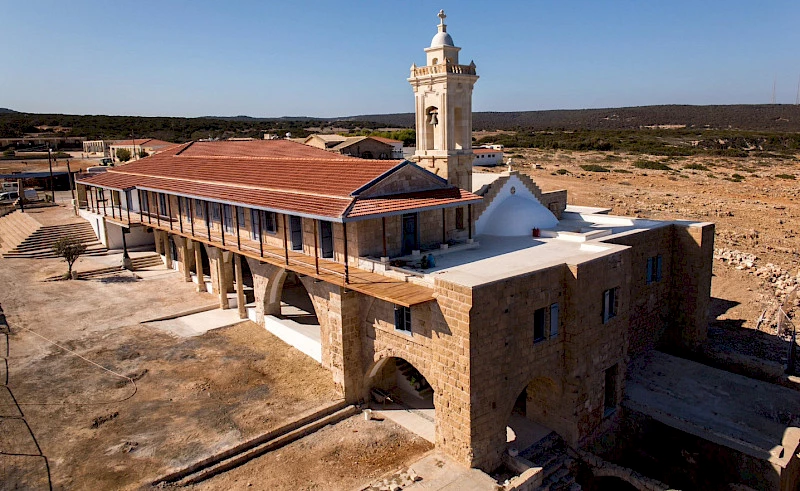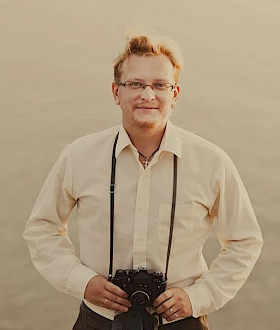Monastery of Apostle Andrew in Northern Cyprus
The Monastery of Apostle Andrew, located at the very edge of the Karpas Peninsula in Northern Cyprus, has long been and remains a place of pilgrimage for Orthodox Christians from the Greek part of the island.
The monastery is dedicated to Saint Andrew, one of the apostles of Jesus Christ, and is renowned for its miraculous spring, which is believed to have healing properties. Below, we will tell you about the history of the monastery and useful tips for visiting, including the location of the miraculous spring. If you find this topic interesting, be sure to read about other Christian churches in Northern Cyprus.

History of the Monastery
The origins of the Monastery of Apostle Andrew date back to Byzantine times, with the earliest mention of a church on this site occurring in the 12th century. According to legend, the monastery was founded after Saint Andrew miraculously saved a ship from a storm in this area by striking a rock from which a spring of fresh water emerged. Over the centuries, the site developed, especially during the Venetian and Ottoman periods. The modern church, built in the 18th century, is a fine example of traditional Cypriot church architecture, combining Byzantine and Frankish elements. The monastery has been a center of worship where pilgrims from all over Cyprus and other countries came to receive the blessings of Saint Andrew.
The year 1974 was a turning point in the history of the Monastery of Apostle Andrew when, after the Turkish invasion of Cyprus, the monastery found itself in the northern part of the island, which came under Turkish control. Pilgrimage by Greek Cypriots to the monastery was greatly restricted, and it began to fall into disrepair due to a lack of maintenance. However, in recent years a new restoration project involving both Greek and Turkish Cypriots has been initiated. This restoration project, funded by international organizations and carried out in stages, has breathed new life into the monastery, preserving its cultural and religious significance for future generations.
How to Get to the Monastery
Visiting the Monastery of Apostle Andrew is an adventure in itself, as it is located at the remote eastern end of the Karpas Peninsula. If you start your journey from Nicosia, you can travel through Famagusta and then follow the coastal road that passes through small villages and picturesque landscapes. Upon arrival, you will find a large parking area.
For those without a car, organized tours from major cities in Northern Cyprus are available, which include transportation to the monastery. However, it is not possible to reach the monastery by public transport. Alternatively, there is a forum on Telegram with a chat called "Excursions" as well as "Taxi" where you can arrange a transfer to the monastery.
- The location of the monastery can be found on the map below the text, or here is a link to Google maps.
- Coordinates for navigation: 35.6593782362873, 34.57436460737915
What to See Nearby
Very close to the monastery, but even further east, is the easternmost point of Cyprus. Additionally, this part of the island is famous for the wild donkeys of Karpas; be sure to bring some carrots for them, otherwise, passing through may be difficult.
Also on the way to Karpas, if you are traveling from Kyrenia, it is worth stopping by Kantara Castle, from which on a clear day (and in Cyprus, it is almost always clear) you can see the Karpas Peninsula with the sea visible on both sides.
Frequently Asked Questions
Is there an entrance fee for the monastery?
No, entrance to the Monastery of Apostle Andrew is free. There is also no charge for candles. However, it is advisable to have some change for charitable donations.
What are the monastery's opening hours?
The monastery is usually open from early morning until sunset, but it is recommended to check the opening hours in advance if you plan to visit on a holiday or a day of religious celebrations.
Can you take photos inside the monastery?
Photography is allowed in most areas of the monastery, but it is recommended to be respectful if there are clergy or worshippers present.
Are there any facilities nearby?
There are basic facilities near the monastery, including a small café and restrooms. However, it is advisable to bring water and snacks, especially if you plan to explore the surroundings.
How to find the spring at the Monastery of St. Andrew?
The spring is located near the old church, which is closer to the sea. You need to go through the arch in the wall and go down the stairs to the left.
Follow us on Instagram and Telegram to learn all the interesting things about the attractions of Northern Cyprus!

